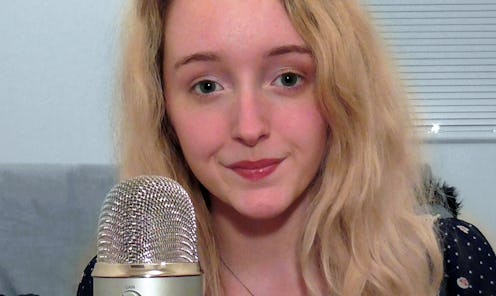Life
How ASMR Videos Help Me Cope with My Anxiety

For most of my life, I've searched for ways to soothe the tightness in my chest, the queasiness in my stomach, and the aches in my head, neck, and back that are triggered by stress and anxiety. I’ve done yoga, listened to meditations, attempted breathing exercises. I've also distracted myself with TV and movies.
But until six months ago, I’d never heard of ASMR. All I knew was that I had a fondness for particular sounds and voices. When people spoke to me kindly and softly, it eased some of the symptoms that came with my anxiety disorder. Certain accents and tones made my body feel tingly and calm. I even noticed random noises, like gentle crinkling and paper shuffling, had a tendency to soothe my anxious states.
It didn’t occur to me to find out whether other people had the same reactions. Instead, whenever I found a YouTube video featuring someone with a voice that calmed me or sounds that relaxed me, I watched it over and over again, enjoying the relaxation I felt while trying not to be too embarrassed by it. I never told anyone my strange secret until I discovered the ASMR community on YouTube.
It turns out that I’m not alone in my love of certain sounds and voices. According to Wikipedia, ASMR, or Autonomous Sensory Meridian Response, is “a euphoric experience characterized by a static-like or tingling sensation on the skin that typically begins on the scalp and moves down the back of the neck and upper spine, precipitating relaxation.”
Although it sounds scientific, only one study has been published on the phenomenon, despite the fact that everyone in the world experiences physical responses to sounds. ASMR is along the same lines of getting frightened by a loud noise or cringing at nails on a chalkboard, except instead of a negative response, these sounds promote relaxation. The 2015 study found that 98 percent of people who seek out ASMR videos watch them for relaxation purposes, and 70 percent watch them specifically for stress and anxiety relief. Many participants added that they use ASMR videos to help where other therapeutic and medical interventions have failed to make a difference.
Once I stumbled upon the term, I fell into a rabbit hole of ASMR YouTube videos for every ASMR trigger imaginable. The ASMR video creators, known as ASMRtists, are a growing community of YouTubers who create videos for the purpose of relaxing people. There are videos with soft spoken voices, whispering, accents, crinkling, writing sounds, keyboard typing, tapping, water pouring, and so much more. You can also find ASMR unboxings, product reviews, and video game Let’s Plays.
There are even roleplay videos where ASMRtists pretend to be doctors, nurses, receptionists, librarians, shopping assistants, and pretty much anyone else you can imagine. Roleplays are some of my favorite videos because my ASMR is often triggered in comforting and safe situations, like speaking to a kind nurse in a doctor’s office or a friendly shop keeper helping me find something I’m looking for.
Some of these videos have millions of views. There’s also a very active ASMR Reddit where users share the videos they’ve enjoyed.
In her Elite Daily article, Megan Cary talks about how ASMR has been invaluable in managing her insomnia: “ASMR has not only given me hours of sleep back, but it has also given me hours of my life back.” She says that the videos help her turn her mind off and get her to sleep much faster. Lifehack also published an article about reducing stress with ASMR, citing ASMR as a creative way to manage anxiety through the euphoric and relaxing state these videos can inspire.
Unfortunately, there’s a real stigma around ASMR. Many mistakenly think the videos, especially the role plays, are designed for erotic purposes. According to the study, only five percent of participants used ASMR videos for sexual stimulation. For some, certain sounds like whispering and soft speaking stimulate intimacy and pleasurable sensations. But the primary purpose of ASMR videos is to promote relaxation and ease anxiety.
It can take time to find the triggers that work for you, and there are people who don’t feel anything while watching ASMR videos. Chances are, if you have ASMR, you probably already know it and have an idea of what you respond to. Either way, it’s worth checking out, especially if you struggle with stress and anxiety.
My favorite ASMRtists include Laura Lemurex, GentleWhispering, TheUKASMR, Springbok ASMR, and ASMRrequests, but there are hundreds of wonderful ASMR video creators to choose from.
If you’re still not sure what to think of ASMR, or you’re a fellow ASMR admirer having trouble explaining it to your loved ones, this video created by psychologist Dr. Robert Duff does a great job of describing ASMR and the ASMR community:
I’ve been hesitant to tell people about my love of ASMR videos, but I know that I shouldn’t be. I watch ASMR videos when I’m feeling anxious, having trouble sleeping, experiencing pain, and even when I’m depressed or discouraged. Anything that can help soothe anxiety, depression, and chronic pain for so many people is clearly a valuable resource, no matter how odd it might seem.
Image: Laura Lemurex/YouTube